Google Gemini’s Pokémon Success and Its Hidden Limitations

Earlier this year, Anthropic’s Claude struggled to beat Pokémon Red despite months of effort. In contrast, a Twitch-streamed campaign using Google’s Gemini 2.5 model recently completed Pokémon Blue after 106,000 in-game actions — a feat even praised by Google CEO Sundar Pichai. But before we hail this as proof of LLM superiority or a milestone toward AGI, it’s crucial to unpack the technical scaffolding that made Gemini’s victory possible.
The Role of the Agent Harness
The core differentiator wasn’t raw model power but the external “agent harness” designed by developer JoelZ. This harness provides:
- State extraction: OCR and pixel-level processing translate the game screen into structured data.
- Memory management: Summaries of past actions live in a retrieval buffer, keeping the 128k-token context window coherent.
- Tool invocation: Built-in primitives let Gemini issue movement, battle commands, and inventory queries.
By comparison, Anthropic’s Claude experiment ran on a minimal framework, forcing the model to hallucinate state or ignore complex map layouts. As JoelZ notes, “You can’t directly compare these results without accounting for the support each model gets.”
Overlay and Navigation Tools
Both projects generate a tile-based overlay superimposed on the Game Boy screen. But Gemini’s harness adds critical metadata:
- Passability flags: Each tile is tagged as walkable or blocked, preventing illegal moves.
- Textual minimap: A live, high-level graph of explored areas helps plan multi-screen paths.
This minimap uses a procedurally generated adjacency matrix, enabling a breadth-first search (BFS) agent to compute routes in O(n + m) time, where n is tile count and m is edge count. Claude’s framework lacked such explicit graph representations, forcing it into dead ends and aimless backtracking.
Specialized Task Agents
Beyond the base model, JoelZ integrated two auxiliary Gemini agents:
- Maze Solver: Implements BFS to navigate Victory Road caverns.
- Puzzle Planner: Utilizes constraint-satisfaction heuristics for the Boulder Puzzle.
These agents run on separate GPU pods in Google Cloud’s Vertex AI environment, each fine-tuned with reinforcement learning from human feedback (RLHF) to accelerate decision-making. Without these modules, even Gemini stalls on repetitive puzzles.
Technical Deep Dive: Agent Harness Architecture
The harness is built atop a microservices architecture deployed on Kubernetes. Key components include:
- Screen Ingestor: A Python Flask service performing real-time screen captures via RetroArch APIs.
- Preprocessor: A TensorFlow Lite model detecting UI elements and dialog boxes with 98.7% accuracy.
- Action Router: A GoLang controller that queues commands and synchronizes with the emulator’s frame rate.
Inter-service communication uses gRPC over an internal VPC, ensuring sub-10ms latency for round-trip requests. This low latency is crucial for games requiring frame-perfect inputs.
Comparison with Reinforcement Learning Approaches
Specialized RL agents have beaten Pokémon more efficiently:
- Deep Q-Networks (DQNs) trained on millions of simulated playthroughs finish in under 1,000 actions.
- Random exploration strategies eventually succeed but lack generalization to new game versions.
By contrast, LLM-driven play combines natural-language reasoning with symbolic search. However, the heavy reliance on external tools undermines claims of “generalized learning.”
Implications for AGI Development
The broader question is whether beating a childhood video game signals progress toward Artificial General Intelligence. Experts remain cautious:
- Dr. Julian Bradshaw (LessWrong) warns that without harness standardization, results are incomparable across models.
- Anthropic’s Dr. David Hershey notes that “missing spatial reasoning and memory consolidation are core LLM pain points.”
- Google researchers hint at Gemini 3’s upcoming 1M-token context window and multimodal transformer improvements, yet spatial navigation remains a frontier challenge.
Until models can independently build and update world models—akin to human mental maps—their “success” in tasks like Pokémon Blue will hinge on external scaffolding.
Conclusion
Google Gemini’s completion of Pokémon Blue is technically impressive but should not be mistaken for raw LLM prowess. The extensive agent harness, specialized sub-agents, and cloud orchestration do much of the heavy lifting. As the AI community awaits Gemini 3 and other next-gen models, the real test will be end-to-end reasoning without bespoke toolchains. Only then can we claim genuine advancement toward AGI.